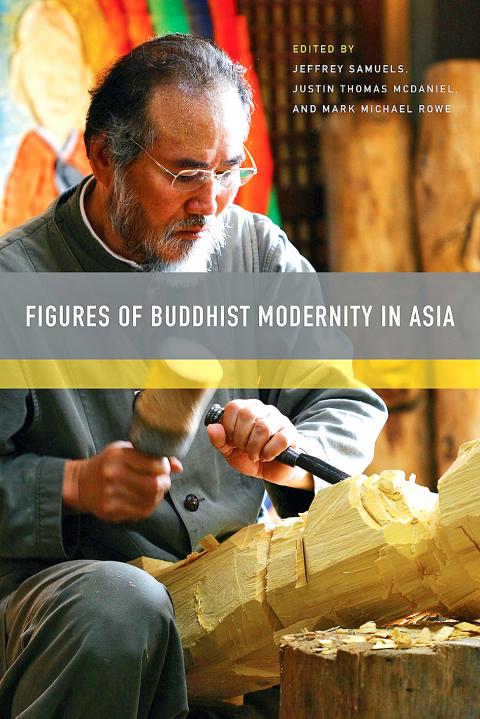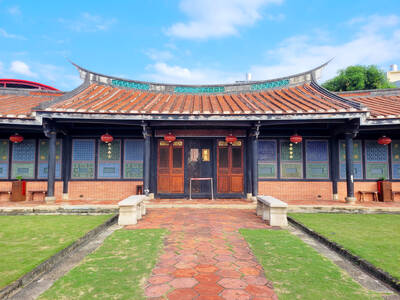A layman devoting himself to the creation of digitally animated cartoons of Buddhist mythology in vibrant red, orange and purple; an educator who has introduced radical reforms such as the study of psychology and Western philosophy into Buddhist seminary curricula and a translator and New Age apologist with a background as a movie star — these three Taiwanese Buddhists feature in this new book about devotees throughout Asia who strive to integrate, in their very different ways, traditional Buddhist teachings with the modern world.
Figures of Buddhist Modernity in Asia is a collection of profiles of individuals who combine religious tradition with contemporary life. They range from, in the words of the editors, “Buddhist Web masters in Taiwan, members of international Buddhist women’s organizations in Vietnam, internationally known singing nuns in Nepal, Buddhist air-traffic controllers in Burma” to “alcoholic translators of Confucian texts in Laos … charlatans, hucksters, profiteers and rabble-rousers.”
The first Taiwanese to be discussed is known by the simple name of Cide. He works out of the Posha Shan Faming Temple in Zhonghe in New Taipei City, and is the son of the former businessman turned abbot, Chanjing, who heads the temple. Cide is a follower of the famous reforming Chinese monk Taixu (1890 to 1947), a key figure in “Humanistic Buddhism.”

Central to Cide’s work is the Internet. He showed the interviewer a clip from the then incomplete digitally animated cartoon of the Sutra of Maitreya’s Ascent, and in addition there are Web sites devoted to the temple’s history (it was once the current abbot’s factory) where the delights on offer include virtual lamp-lighting.
The profiles that comprise this book are all penned by different people, and the profiler and interviewer responsible for this item says Cide represents crucial aspects of modern Taiwan — economic development put to other — in this case spiritua — uses, increased links with China and, in the specifically Buddhist context, the “growing but ambivalent” role of lay leadership.
The second Taiwan personality featured is the monk known as Houguan (厚觀). Born in Miaoli County in 1956, he studied under the celebrated Dharma Master Yin Shun (印順法師, 1906 to 2005) who’s credited with spearheading Taiwanese Buddhist modernity. Yin Shun’s most famous pupil is the Master Cheng Yen (證嚴法師) who founded the hugely successful Tzu Chi Foundation. But in the field of Buddhist education it’s Houguan who is the star figure.
He’s credited with upgrading the curricula of Buddhist seminaries, pioneering the use of new media in teaching both monastics and laity and making strenuous efforts to arrange cross-strait Buddhist symposia. Also important is his incorporation of the reforms undertaken in China by Taixu, exemplified by the inclusion of secular subjects such as psychology and Western philosophy, plus a critical and philological approach to ancient Buddhist texts. This can be compared to the textual criticism of the Bible (who wrote which books, can they all be considered authentic?) pioneered against strenuous opposition in Germany in the early 19th century.
Houguan has spent much of his life as dean and teacher at Taiwan’s Fu Yan Buddhist Institute (福嚴佛學院). He’s also president of the Yin Shun Buddhist Cultural Foundation, an organization that promotes Yin Shun’s teachings.
Modern technology also features in his teaching practice. The Fu Yan Buddhist Institute has a Web site that contains “all the notes” of Houguan’s and other teachers’ lectures as downloadable files. It also has its own channel on YouTube where Houguan and his colleagues can be watched lecturing in regularly uploaded videos.
The third Taiwanese Buddhist celebrity to be featured in this book is Terry Hu (胡因夢). Born in 1953, she was once a popular movie star, but then went on to be a promoter of the books of the Indian Theosophist called Jiddu Krishnamurti (1895 to 1986). However, she had her own take on his writings, re-launching him in Taiwan as an essentially Buddhist figure.
Having the popular touch is central to Hu’s style. At one public meeting in Taipei in 2013 she was accompanied on the platform by a physics professor and tai chi exponent and a cosmetics entrepreneur. Earlier in her life, in 1979, she’d met the prominent Taiwanese writer and public intellectual Li Ao (李敖) who she “quickly married and divorced,” according to the author of this profile.
After working in the US, she returned to Taiwan in the 1980s and became deeply involved in the emerging New Age movement. In her 1987 guide to the New Age, Ancient Future (古老的未來), she criticized what she saw as the authoritarian tendencies of Chinese culture in Taiwan. She also argued that Krishnamurti’s later work exemplified the essence of Zen Buddhism, despite his never having used the term. She also stressed how anti-authoritarian in general New Age teachings were, and introduced Buddhist terminology wherever possible in order the make the movement more accessible to her Taiwanese readers.
Also profiled is Columbia University’s Yu Chun-fang (於君方), author of the monumental Kuan-yin: The Chinese Transformation of Avolokitesvara (2001). Her grandmother had been an ardent devotee of Guanyin (觀音), but following the family’s move from China to Taiwan Yu was moved to comment that from the 1950s to the 1970s Buddhism had a far lower profile in Taiwanese universities than Christianity. It was only when she realized that the perspective in American academic life was very different that she felt ready to embark on her great work.
This is an exceptional book as regards its sheer range, but its Taiwan-related material is especially insightful. Its position is that Taiwan is unique in the way it combines progressive modern technology and its related attitudes (almost always libertarian) with ancient, traditional Buddhist insights. As such, it is positioned to be the Asian leader in such matters, if it hasn’t already become so.

Last week saw the appearance of another odious screed full of lies from the People’s Republic of China (PRC) Ambassador to Australia, Xiao Qian (肖千), in the Financial Review, a major Australian paper. Xiao’s piece was presented without challenge or caveat. His “Seven truths on why Taiwan always will be China’s” presented a “greatest hits” of the litany of PRC falsehoods. This includes: Taiwan’s indigenous peoples were descended from the people of China 30,000 years ago; a “Chinese” imperial government administrated Taiwan in the 14th century; Koxinga, also known as Cheng Cheng-kung (鄭成功), “recovered” Taiwan for China; the Qing owned

Jan. 20 to Jan. 26 Taipei was in a jubilant, patriotic mood on the morning of Jan. 25, 1954. Flags hung outside shops and residences, people chanted anti-communist slogans and rousing music blared from loudspeakers. The occasion was the arrival of about 14,000 Chinese prisoners from the Korean War, who had elected to head to Taiwan instead of being repatriated to China. The majority landed in Keelung over three days and were paraded through the capital to great fanfare. Air Force planes dropped colorful flyers, one of which read, “You’re back, you’re finally back. You finally overcame the evil communist bandits and

I am kneeling quite awkwardly on a cushion in a yoga studio in London’s Shoreditch on an unseasonably chilly Wednesday and wondering when exactly will be the optimum time to rearrange my legs. I have an ice-cold mango and passion fruit kombucha beside me and an agonising case of pins and needles. The solution to pins and needles, I learned a few years ago, is to directly confront the agony: pull your legs out from underneath you, bend your toes up as high as they can reach, and yes, it will hurt far more initially, but then the pain subsides.

When 17-year-old Lin Shih (林石) crossed the Taiwan Strait in 1746 with a group of settlers, he could hardly have known the magnitude of wealth and influence his family would later amass on the island, or that one day tourists would be walking through the home of his descendants in central Taiwan. He might also have been surprised to see the family home located in Wufeng District (霧峰) of Taichung, as Lin initially settled further north in what is now Dali District (大里). However, after the Qing executed him for his alleged participation in the Lin Shuang-Wen Rebellion (林爽文事件), his grandsons were